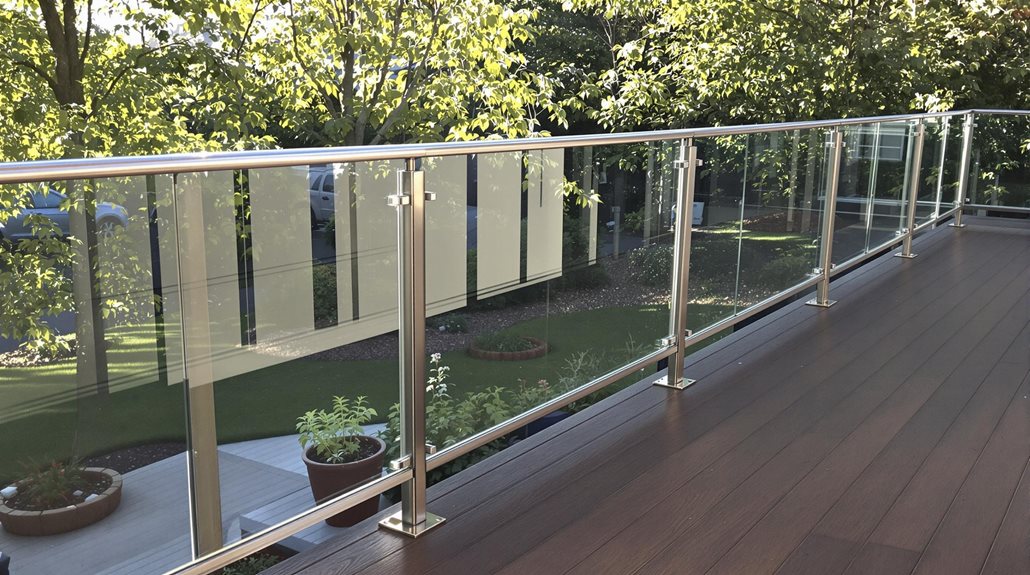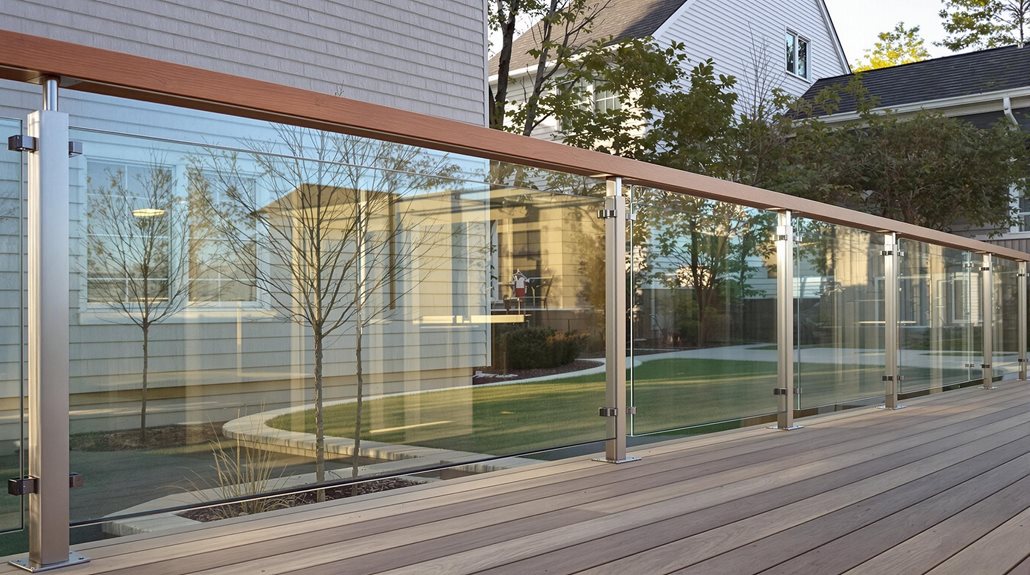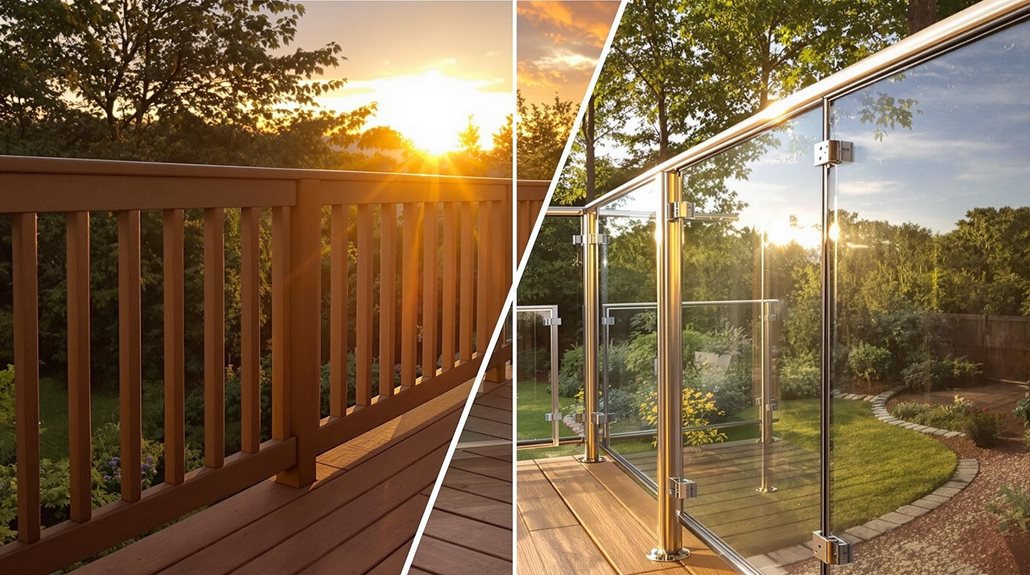Deck Railing Options: Combining Safety With Style in Your Outdoor Space
When designing or renovating an outdoor deck, selecting the right railing options is vital for combining safety with style. Wood railings offer a traditional look but require regular maintenance, while metal options like aluminum and steel provide a modern appearance with low maintenance but at a higher cost. Vinyl/PVC and composite materials like TimberTech AZEK® and Trex are durable and easy to maintain. Ensuring railings meet local building codes, such as a minimum height of 36 inches and 4-inch baluster spacing, is essential for safety. By choosing materials that balance aesthetic appeal with durability and safety features, homeowners can create an inviting outdoor space that is both functional and visually appealing. For more detailed guidance on making the best choice for your deck, consider exploring the various material options and design styles available.
Expert Highlights
- Choose materials like wood, metal, vinyl/PVC, or composites that balance aesthetic appeal with durability and maintenance needs.
- Select design styles (Modern Minimalist, Traditional Classic, Rustic Charm) that match your home's architecture for seamless integration.
- Ensure safety by adhering to local building codes, maintaining a minimum railing height of 36 inches, and keeping baluster spacing under 4 inches.
- Opt for smooth surfaces and regular inspections to prevent injuries and ensure the structural integrity of the railings.
- Consider budget-friendly options like vinyl and wood or luxury choices like aluminum and stainless steel based on your budget and maintenance preferences.
Material Options for Deck Railings

When it comes to deck railings, the choice of material is an essential decision that can greatly impact both the aesthetic appeal and the durability of your outdoor space. One of the primary challenges is finding a material that balances style with safety and longevity.
Wood, for instance, offers a traditional look but requires regular maintenance to prevent rot and insect damage.
Metal railings, such as aluminum or steel, provide a modern appearance and are generally low-maintenance, though they can be more expensive.
Vinyl or PVC railings are another option, known for their resistance to weathering and ease of upkeep, making them a practical choice for many homeowners.
Each material has its unique benefits, allowing you to select one that aligns with your needs and preferences.
For a low-maintenance solution that combines durability with aesthetics, composite deck materials from brands like TimberTech AZEK® and Trex offer exceptional weather resistance while mimicking the appearance of natural wood.
Design Styles to Match Your Home
How do you guarantee that your deck railing not only serves its functional purpose but also complements the overall aesthetic of your home?
The key lies in selecting a design style that aligns with your home's architecture and interior decor. Here are some design styles to evaluate:
- Modern Minimalist: Characterized by clean lines, simple shapes, and a focus on functionality. This style is perfect for contemporary homes and can be achieved with materials like stainless steel or glass.
- Traditional Classic: Featuring ornate details, wood accents, and a timeless appeal. This style suits traditional or Victorian homes and can be enhanced with wooden railings and decorative balusters.
- Rustic Charm: Embracing natural elements such as wood and stone, this style is ideal for country or rustic homes. It adds a warm, inviting touch to the outdoor space.
Each style guarantees that your deck railing is both safe and visually appealing, enhancing the overall look of your home.
Our custom solutions focus ensures your chosen railing style seamlessly integrates with your home's unique architectural features.
Safety Features to Consider

Guaranteeing the safety of your deck railing is essential, as it directly impacts the well-being of those using the deck. One of the primary safety features to take into account is the height and stability of the railing.
A railing that is too low or unstable can lead to accidents, especially for children and elderly individuals. To address this, verify that your deck railing meets local building codes, typically requiring a minimum height of 36 inches for residential decks.
Another important aspect is the spacing between balusters. Gaps should not exceed 4 inches to prevent children from slipping through.
Additionally, reflect on using guardrails with a smooth surface to reduce the risk of injuries from sharp edges.
Regular inspections and maintenance are also vital to identify and repair any damage or wear, confirming your deck remains a safe and enjoyable space for everyone.
Working with expert deck contractors ensures proper installation and compliance with safety regulations while maintaining aesthetic appeal.
Maintenance and Durability
Maintaining the durability of your deck railing is essential to confirm it remains a safe and aesthetically pleasing part of your outdoor space.
Over time, railings can suffer from weather damage, wear, and tear, which can compromise their structural integrity.
Here are some key considerations to confirm your deck railing remains durable:
- Regular Inspections: Periodically check for signs of damage or deterioration, such as rotten wood, rust, or loose components.
- Material Choice: Select materials known for their durability, such as hardwoods, metal, or composite materials that are resistant to weathering and pests.
- Proper Installation: Confirm that the railing is installed correctly according to manufacturer guidelines to prevent premature wear and confirm longevity.
Using premium decking materials like Trex, Timbertech, or Azek can significantly extend the life of your outdoor structures while reducing maintenance requirements.
Budget-Friendly vs. Luxury Choices

When it comes to choosing deck railing options, one of the most significant decisions homeowners face is whether to opt for budget-friendly or luxury choices. This decision can be influenced by several factors, including the overall aesthetic of the home, the desired level of durability, and the available budget.
| Feature | Budget-Friendly | Luxury |
|---|---|---|
| Material | Vinyl, Wood | Aluminum, Stainless Steel |
| Cost | Lower | Higher |
| Maintenance | Moderate | Low |
| Appearance | Simple, Classic | Sleek, Modern |
Budget-friendly options like vinyl and wood railings offer a cost-effective solution while still providing essential safety and a classic look. Luxury choices, such as aluminum and stainless steel, offer superior durability and a sleek, modern aesthetic but come at a higher cost. Homeowners must weigh these factors to find the perfect balance between style and budget. Our extensive selection of railings ensures that every client can find options that complement their home's architecture while meeting local building codes.
Frequently Asked Questions
Can Deck Railings Be Installed by a Homeowner Without Professional Help?
Homeowners can install deck railings themselves, but it requires careful planning, adherence to local building codes, and some DIY skills. Ensuring stability and safety is essential, so thorough instructions and possibly some practice are necessary.
How Do Local Building Codes Impact Deck Railing Choices?
Local building codes greatly influence deck railing choices by mandating specific heights, materials, and design elements to guarantee safety and structural integrity. These codes vary by region and must be adhered to during installation. Compliance is essential to avoid fines and guarantee the railing meets safety standards.
Are There Any Eco-Friendly Options for Deck Railings?
Eco-friendly deck railing options include sustainable materials like recycled plastic, cedar, and bamboo. These materials are durable, require minimal maintenance, and reduce environmental impact. Additionally, reclaimed wood and FSC-certified hardwoods are also popular eco-conscious choices.
Can Deck Railings Be Painted or Stained After Installation?
Deck railings can indeed be painted or stained after installation, depending on the material. Wood railings are commonly painted or stained, while metal and composite materials may require special coatings or treatments to guarantee durability and appearance.
Do Deck Railings Affect the Resale Value of a Home?
Deck railings can greatly impact the resale value of a home. Well-maintained, stylish, and safe railings enhance curb appeal and outdoor living space, attracting potential buyers and potentially increasing the property's value.
Expert Final Thougts
When selecting deck railing options, it's vital to balance safety and style. By choosing materials like wood, metal, or composite, homeowners can guarantee durability and aesthetic appeal. Design styles should complement the home's architecture, while safety features such as gate latches and vertical balusters must be prioritized. Regular maintenance is key to longevity, and budget-friendly choices like vinyl can offer comparable benefits to luxury materials. Ultimately, a well-designed deck railing enhances both the functionality and beauty of your outdoor space.



